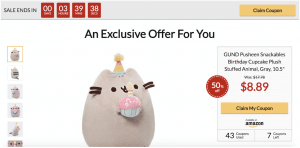Editor’s note: This is a guest post by Thomas Pruchinski, Head of Marketing, Growth & Partnerships at LandingCube
Selling on Amazon is a great way to build a successful business. However, Amazon.com is super competitive and being totally dependent on Amazon can be risky for a brand. External sources of traffic offer Amazon sellers additional ways to find customers, edge out the competition and build a more robust brand. This article will explain how & why Amazon sellers could utilize traffic sources outside of Amazon (ie Facebook, GoogleAds, Influencers).
Why is it important to drive traffic from external channels?
Lots of searches take place on Amazon.com everyday by people primed to buy (hence their membership program named Prime) – in fact half of all online product searches begin on Amazon. But your keywords have a limited amount of searches and your listing gets a limited amount of hits. By using external sources of traffic, you can search for potential customers and get your products / brand in front of them. These are customers your competitors aren’t marketing to. If you drive traffic the the right way, you can stay on Amazon’s good side (they might even throw you some help), while building an email list to develop relationships and move leads toward becoming paying customers.
Stay ahead of the competition
Ok. So you’re selling on Amazon, and your listings are optimized- High quality images, compelling copy & targeting the right keywords. That’s great! The bad news? So is everyone else.
Getting to the top of Amazon’s search rankings is incredibly competitive. Even if you do show up on the first page and a customer sees your listing, they also see many of your competitors’ listings.
By getting in front of customers on external channels like Facebook, blogs or Pinterest, you can more easily stand out from the competition.
Amazon rewards listings that drive traffic
While it’s not proven (Amazon’s algorithm remains quite mysterious), it’s generally accepted that Amazon rewards listings that receive external traffic with increased rankings. It makes sense, doesn’t it? Amazon is a business, like yours. They want more people buying products off their site
Diversify your customer base with long-term customers
Optimizing your Amazon SEO and making a lot of sales on Amazon is a great goal (and should probably take precedence over driving traffic if your primary goal is sales on Amazon). However, it should be noted that when customers buy your products on Amazon, these aren’t your customers. They’re Amazon’s.
To build a successful business, you need a sustainable model. You don’t just sell products – you create a brand. The methods you use to make one product launch a success may not work for the next. If you have a strong brand and an existing customer base, your chances are greatly improved.
The problem is that Amazon doesn’t give you the means to do this, out of fear that you might take their customers and sell to them yourself. But if you capture them before they hit Amazon, they become your customers.
Build an email list
This is a key part of building a long-term customer base, and growing the value of your business. An email list of past or potential customers lets you engage with them, build a relationship and market future product launches.
As we mentioned above, Amazon won’t give you customer emails. But by driving traffic from outside channels you can collect emails and stay within Amazon’s TOS.
Capturing emails from your customers is a great way to encourage them to leave reviews, which will benefit your products’ search performance and conversion rates. [Want to generate more Amazon product reviews to grow your business? Check out this free guide]
Finally, having an email list is a great way to hedge risk. If you get kicked off Amazon, without an email list, you have no customers. An email list allows you to salvage your business if the worst happens.
Amazon sellers can do a lot with emails to build their business and grow their brand. This article shows 10 different types of emails FBA sellers can employ, while staying in Amazon’s good books.
How to effectively drive external traffic
You’ve seen the value in external traffic sources, and you’ve decided to go for it. Great choice! But if you don’t know how to capture traffic effectively, you may end up with a lot of ad spend for very little change in conversion rates.
Let’s go over how to do it right, and the most common mistake people make when capturing external traffic.
The #1 mistake
A lot of sellers do the hard work advertisingAdvertising is a means of communication ... More and driving traffic to Amazon, but make one big mistake. They send traffic straight to their listing.
Why is this a mistake? By sending customers directly to your listing, you’re sacrificing a long-term relationship for a (potential) immediate sale. Without collecting contact info (or tracking data), if they don’t buy right then and there, you miss out on potential future sales. It’s important to put the customer through a sales funnel, which allows you to capture emails and market directly to them, before they land on the product page.
Sending traffic straight to Amazon may also negatively affect your rankings. External traffic tends to see lower conversion rates than traffic internal to Amazon. So, while sending all traffic straight to your listing will increase views, it will lower your conversion rates. Many in the industry believe conversion rate plays a part in Amazon’s search algorithm. So this could actually be hurting your rankings.
Landing Pages
Instead of driving traffic straight to Amazon, it’s better to first drive traffic to a landing page. By driving traffic first to a landing page, you accomplish two things. First, you filter the traffic to improve conversion rates – people unlikely to buy bounce on the landing page, instead of on the Amazon listing. And those who do click-through to the Amazon listing are even more likely to buy. Second, the landing page allows you to collect contact info (and track visitors with code, ie Facebook Pixel), for future marketing purposes.
On the landing page, you should offer something enticing to get the visitor to part with their email, all in service of them eventually buying your products. Examples of this might be free content giveaways (such as an informational e-book that helps them get more value out of your product), or a one-time discount on purchase.
There are two types of landing pages you can use:
- General Purpose landing pages
This type of landing page is a good option if your primary goal is to collect contact info, rather than boosting sales & rankings on Amazon. With these it’s best to offer free content, that leads people toward eventually becoming your customer. There are many tools to help you build this type of landing page, such as LeadPages or MailChimp’s landing page tool.
2. Amazon-specific landing pages
This is your best option, if your primary goal is to boost sales & rankings on Amazon. A dedicated Amazon landing page generator like LandingCube gives you the ability to offer single-use promo codes in exchange for the customer’s email.So the customer gets a discount on a great product, and you get additional sales on Amazon. And Amazon rewards you with higher rankings, ie additional traffic.

Landing pages allow you to create an efficient, effective sales funnel, which is vital for you to optimize your conversion rates and get the most out of your externally driven traffic.
A sales funnel for your Amazon businessAmazon Business is Amazon’s wholesale ... More might look like this:
First, you get in front of potential customers wherever they might be on the web. They land on the landing page. If they like the offer, they put in their email and hopefully buy right then and there. And your Amazon rankings get a boost, so Amazon sends you more visitors. If they don’t buy, you still have their email to move them toward buying in the future.
Which traffic source is the best?
There are so many ways you might find external traffic. Which is the best? The short answer is, it depends.
The best source will depend on your product and your target market. If you have an existing email list, this is a great place to start. Email campaigns allow you to send promotions to people interested in your brand.
Facebook ads are an effective channel for many sellers. Facebook offers you a powerfully sophisticated targeting tool and a wide existing user base on Facebook and Instagram.
If your products are visually-based and targeted toward women, Pinterest could be a better way to attract traffic and drive them to your landing page.
The best way to know what source is best for you is to experiment. Have a look at your target niche or demographic and pick a source you think seems promising. Trial it for a short amount of time with a set goal in mind. After your trial period, check the results. If it works, that’s great! If not, try another channel and see if your results improve.
In Summary
Many sellers are successful from Amazon alone. But relying on Amazon is risky, and leaves a lot of potential customers untapped.
To build a brand that lasts, take advantage of all the traffic channels you can. External traffic allows you to put together an email list and make deeper relationships with your customers.
Combine a steady stream of external traffic with an effective sales funnel, and you’ll be able to maximize the earning potential of your Amazon business.

Thomas Pruchinski worked on two e-commerce brands in the health space. His focuses were on growing Amazon sales, email marketing & influencer partnerships. He joined forces with LandingCube in December 2016 as the first marketing hire to help Amazon sellers grow their brands by leveraging traffic sources outside of Amazon.









One Response
We tried like heck to work with LandingCude. We never heard back. Not sure if they are even a real company…or just an outsourced software that may or may not work.